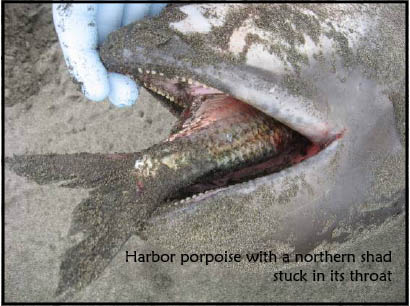|
An empty belly, a full mouth...
There are the usual marine mammal calls a stranded baby seal, a dead elephant seal, a cranky sea lion on the
beach and then there are the unusual ones. In the almost fifteen years Aquarium staff have been responding
to Marine Mammal Stranding Network calls, we have had many unusual occurrences. There was the sea lion stopping
traffic on a road in Southern Washington (it ran into the forest before it was eventually caged and returned to the
water), and the Baird’s Beaked Whale that washed ashore and died in front of the Turnaround in Seaside during the
 annual volleyball tournament. We have helped a beaver stranded on a bar in the surf at the cove (technically not a
marine mammal, but somehow it was in our purview) and green and leatherback sea turtles washed ashore and
suffering from hypothermia. We have examined dead gray whales, humpback whales, sperm whales, dolphins,
elephant seals, and sea lions.
annual volleyball tournament. We have helped a beaver stranded on a bar in the surf at the cove (technically not a
marine mammal, but somehow it was in our purview) and green and leatherback sea turtles washed ashore and
suffering from hypothermia. We have examined dead gray whales, humpback whales, sperm whales, dolphins,
elephant seals, and sea lions.
It is not that unusual for a harbor porpoise to wash up dead on the beach; it is more unusual for the porpoise to have
starved with a fish in its mouth. Harbor porpoises are slightly smaller than other porpoises (they grow to 6 feet) and
eat small fish like herring and smelt. Occasionally a harbor porpoise will
eat a shad, a fish similar to herring but slightly wider. Shad are built with
very bony dorsal (back) and ventral (belly) fins that are similar to
porcupine needles they are smooth when rubbed one way but sharp
when rubbed another. If a harbor porpoise starts to swallow a shad that is
too large, it will try to spit it back out, and the shad’s fins will get caught in
the porpoise’s throat. Eventually the fins pierce the porpoise’s esophagus,
leaving the fish irreparably lodged.
Over the years, aquarium staff have discovered three harbor porpoises that
have died in this manner. The most recent incident was this spring.
|
|

